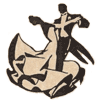 |
ROUND DANCING — CHOREOGRAPHED BALLROOMEDUCATIONAL ARTICLESMAJOR SECTIONS: Figures | Articles | Links | Alph. Index | Search | Home |
|
|
Where Should We Put the Slow In Foxtrot?by Harold & Meredith Sears You might say, well, that’s an easy question. Foxtrot timing is slow, quick, quick. We put the slow first. But, we shouldn’t feel constrained. Do you remember the Dancer’s License that you got when you graduated from your first set of classes? One of the freedoms that it confers is the freedom to play with the timing of the music. The standard in Foxtrot is to step on beat 1, float through beat 2, and then dance our quick steps on beats 3 and 4. Usually this flows well and feels good, but sometimes it limits what the music and the dance (and you) are trying to do. Sometimes it feels mechanical — step, pause, march, march — this is not the military!Our license is to borrow from one part of a measure and use that little bit of time to enhance another part of the measure. We might borrow from the slow to make one of the quicks not quite so quick. The slow becomes a little shorter than two beats, and the enhanced quick becomes a little slower. We might even borrow from a quick, dancing that step in less than one beat, so we can linger more during either or both of the other two steps. Let’s compare a Spin Turn to a Spin Overturn (sometimes Over Spin Turn). In both of these figures, we usually begin in closed position, facing reverse. The man steps back on his left foot (lady forward right), and we begin to pivot right-face. The man steps forward right between the lady's feet, rising and completing the turn, and then he recovers side and back (lady side and forward) to end in closed position with the trail feet free. The standard Spin Turn ends with the man facing line and wall. A Spin Overturn turns more and ends facing wall, reverse and wall, or even reverse line of dance (and the ending position should be cued). So, a Spin Turn goes around 5/8 in one measure of music. How can we go farther around in the same length of time? The answer is that we don’t have to. We can find more time. The key step is the second one. This is where most of the spin occurs. This is also where the “picture” is. We are rising. Our topline is back and to the left. We are soaring around—so graceful. Conventional foxtrot timing would have us do that in only a “quick,” in only one beat of music. It’s not enough. That particular step deserves more. Instead of thinking of this measure of music as consisting of four beats: 1 2 3 4; let’s think of it as consisting of eight half-beats: 1& 2& 3& 4& (And we could divide it even more finely if we were especially mathematical.) In dancing a Spin Turn, and especially a Spin Overturn, we should not slavishly step on 1, 3, and 4. We should consider using more of these half-beats for the second step. It’s the working step. It’s the showy step. What if we stepped on the 1, on the "& of 2", and then on the "& of 4"? We are taking the second step a half-beat early and the third step a half-beat later. We are “milking” beat 3 of this measure. We are getting into that important second step, showing it off, riding the spin around, and simply not thinking about the third step until we get to where we want to be. Then we exit quickly and move on. We might even feel that the first step of this figure is the least important of the three. We might step on beats 1, 2, and 4. That’s more than milking a beat. We’re actually dancing the figure "quick, slow, quick"; but it’s okay. We can put the slow where we want. We can show off the part of the figure that we want to show off.
Originally
published in the Washington Area Square Dancers
Cooperative Association (WASCA) Calls 'n' Cues, June 2008 and
reprinted in the DRDC Newsletter, November 2024.
If you would like to read other articles on dance position, technique, styling, and specific dance rhythms, you may visit the article TOC. Past DRDC Educational Articles archived here. Go beyond this site. Find other references on our Sources and Links pages.
|
 |
|
|
Page last revised